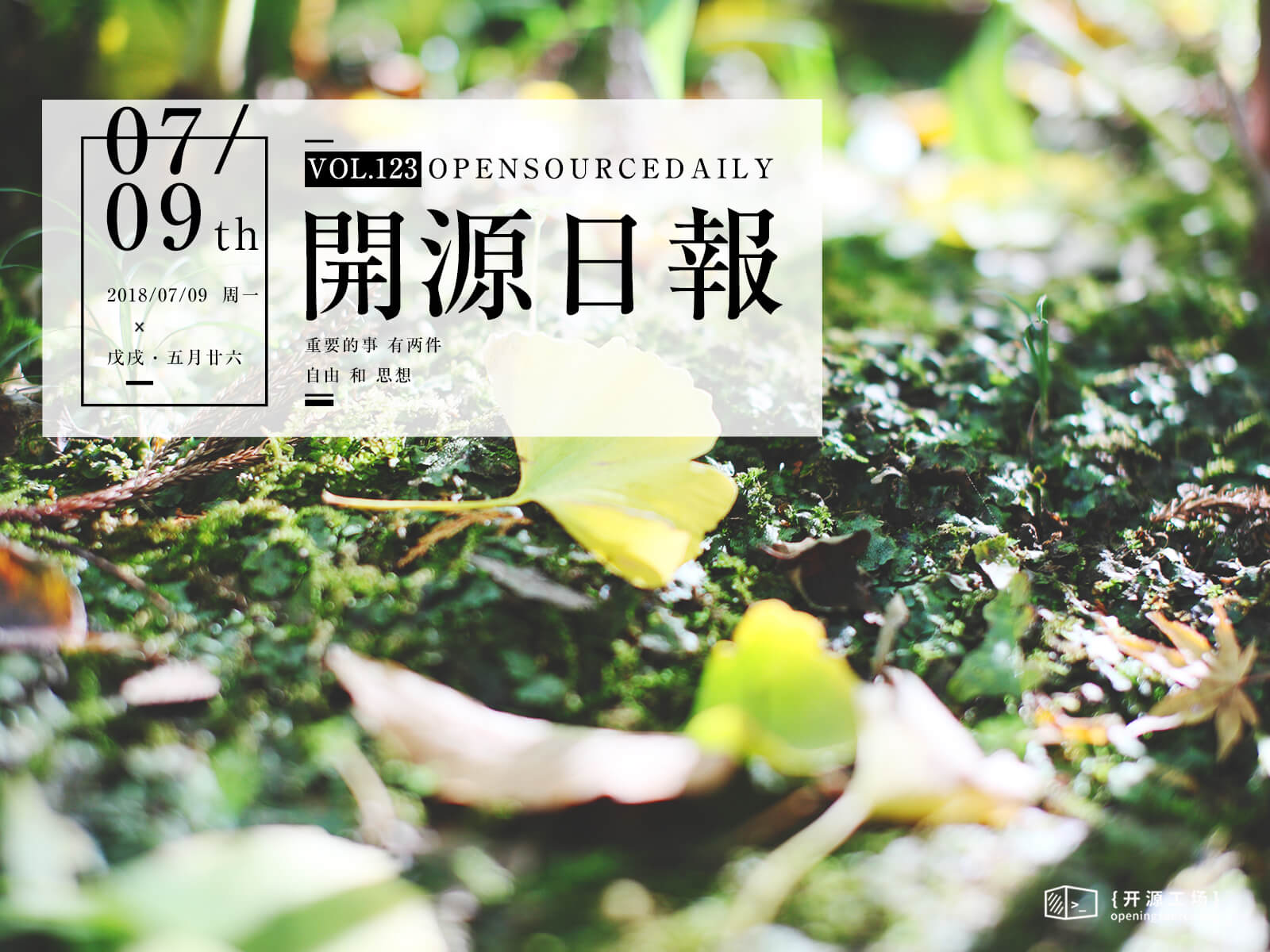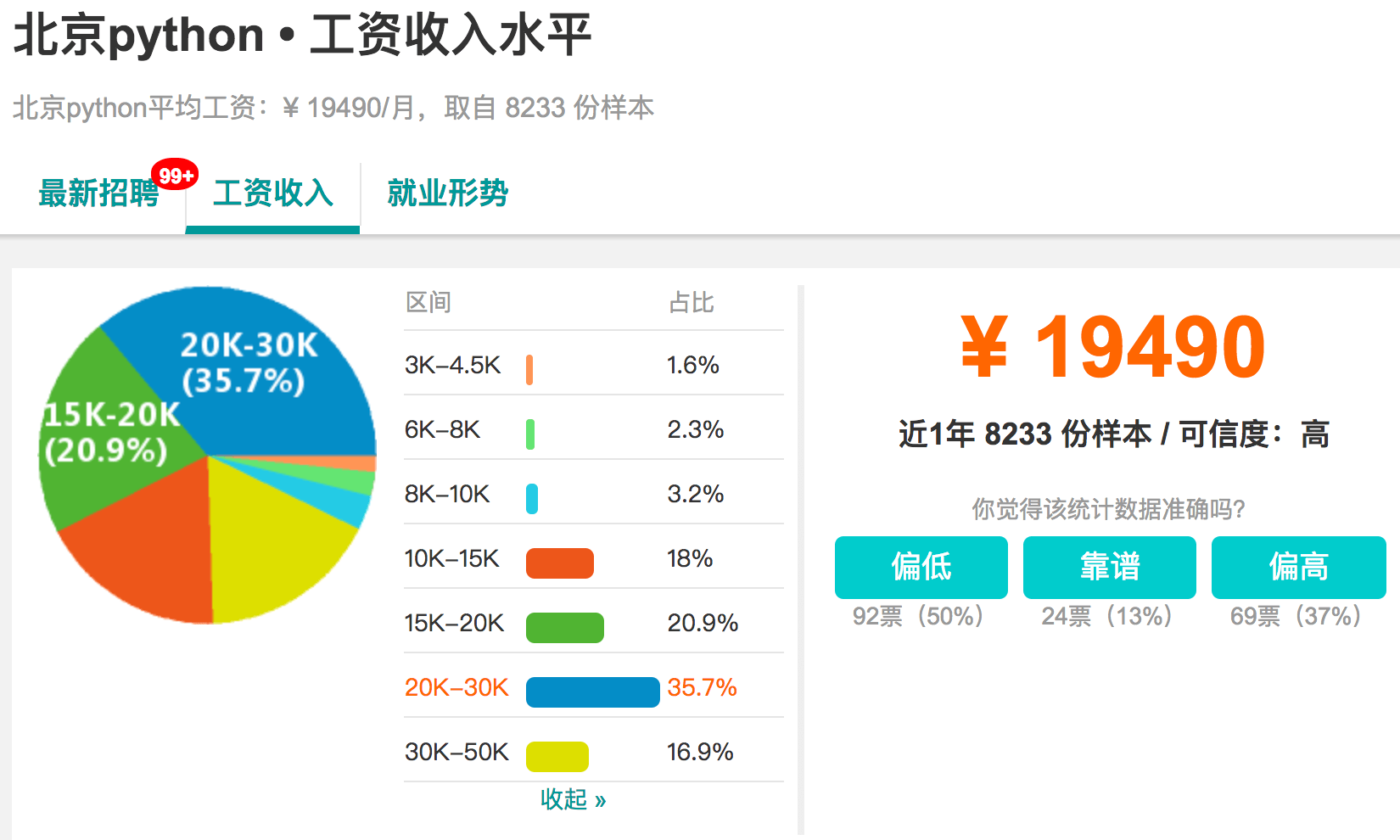每天推荐一个 GitHub 优质开源项目和一篇精选英文科技或编程文章原文,欢迎关注开源日报。交流QQ群:202790710;微博:https://weibo.com/openingsource;电报群 https://t.me/OpeningSourceOrg

今日推荐开源项目:《百日P Python-100-Days》GitHub链接
推荐理由:这个项目是教你学 Python 的。实际上,它不仅教基本的 Python ,还教你可能用的上的 Linux 和 MySQL 这类的,即使你不想学 Python ,也可以从中选择你感兴趣的学习,或者你也可以只是来看看学 Python 的人的工资……讲道理,北京工资是真的高啊。
 Pytho
Pytho
今日推荐英文原文:《Blockchain in action: 5 interesting examples》作者:Kevin Casey
原文链接:https://enterprisersproject.com/article/2018/7/blockchain-action-5-interesting-examples
推荐理由:这篇文章介绍的是区块链在什么地方具有潜力,区块链很复杂,复杂到听不懂,我们也不知道它能在哪些行业派上用场,这篇文章就是解决这个问题的。
Blockchain in action: 5 interesting examples
What will help catalyze more blockchain projects? More real-world examples of blockchain in action. Better still: More examples of blockchain delivering measurable business value in some form, whether cost reductions, new business models, or other tangible benefits that tend to grab the CEO’s attention. Most organizations haven’t seen those examples yet, though.
Ed Price, director of compliance at Devbridge Group, says his firm is kicking the tires on blockchain both internally and in various proof-of-concept projects for its customers – but it has yet to encounter a case where blockchain is the solution rather than one possible solution.
“We always look for the best products or solution to fit the problem and with blockchain, we haven’t found one that required it yet,” Price says. “Given the hype and the customer interest, we continue to look for a good application candidate versus just doing blockchain because we can.”
That’s not a solitary perspective, as shown by some recent Gartner survey stats and other points of view on this emerging technology. As Red Hat technology evangelist Gordon Haff wrote recently, a shipping executive he spoke with saw significant potential in her industry, but not universal adoption, in part because of some key industry challenges.
[ Can you explain blockchain to non-techies? Read our related story, How to explain blockchain in plain English. ]
That doesn’t mean, of course, that blockchain’s potential isn’t significant. As the hunt for tangible business value continues, Price, Haff, and other experts point to a growing list of compelling real and potential use cases for blockchain.
As Haff told us recently: “In deciding whether to use blockchain, it is helpful to think about whether [its] unique characteristics provide business value. For example, if an industry has no system of trusted middlemen – or if existing middlemen are expensive or otherwise add friction – blockchain might be a good fit.”
So let’s look at some of the most interesting examples of blockchain in action.
A quick note: We’re not covering examples from the financial services, banking, fintech, or related industries here; they’re a blockchain story (or many of them) unto themselves. Rather, we’re turning our focus to other industries and applications where blockchain may offer significant potential, or already offers some interesting case studies.
“Blockchain is not just about digital money and finance – there are applications that are relevant in the early stages of exploration in every industry,” says David Schatsky, managing director at Deloitte.
1. Supply chain management
Supply chains are pretty much by definition full of middlemen. International trade, in particular, comes with a dizzying array of complicated logistics. Global trade is also notoriously dependent on a vast amount of paperwork.
Multiple trials and proofs-of-concept have already begun and include some of the major names in global shipping and logistics. A recent blockchain trial on a land-and-sea trade route between Australia and China was declared a success, for example, and a significant proof-of-concept backed by PwC Australia, the Australian Chamber of Commerce and Industry, and the Port of Brisbane recently launched as well.
Expect to see and hear plenty more blockchain buzz in supply chain management, shipping, logistics, and related industries.
“Supply chain management is a significant growth area for blockchain, as a supply chain is a networked phenomenon that tends to be global and complicated in nature, with many participants,” Schatsky says. “At its core, blockchain can foster greater connectivity, trust, communication, and reliability in a networked setting like that.”
Further reading (curated articles from other websites):
- Joint blockchain trial between Australia and China a success
- Australia’s First Blockchain Supply Chain System Unveiled at Port of Brisbane
2. Food distribution and safety
As a specific subset of the massive supply chain category, there are considerable potential uses of blockchain technology in food distribution and safety.
Maryanne Morrow, founder and CEO of fintech blockchain startup 9thGear.io, points to a pilot program in China, a partnership of Walmart, IBM, and Tsinghua University in Beijing, that is testing the efficacy of blockchain in the country’s massive supply chain for pork and food distribution and safety in general.
As Haff and Schatsky both note, blockchain may be a fit where trust is a potential issue – and it’s a huge issue in food supply: where your food comes from, how it was farmed or produced, the veracity of label claims, and so forth. (If you doubt trust is a big issue with food, pay closer attention to the news coverage of the next major food recall.)
Further reading (curated articles from other websites):
- Can blockchain make food safer in China?
- 3 Innovative Ways Blockchain Will Build Trust In The Food Industry
- Why blockchain won’t fix food safety—yet
3. Contracts and law
Aside from blockchain work in the financial sector, so-called “smart contracts” are arguably the biggest innovation to date, according to Christian Kameir, managing partner at the VC firm Sustany Capital, which focuses on blockchain-related investments.
“A smart contract is a blockchain function intended to digitally facilitate, verify, or enforce the negotiation or performance of a contract,” Kameir explains.
A lot of the actual use of smart contracts to date has been connected directly to initial coin offerings, or ICOs, and the creation of new cryptocurrencies; Kameir notes that thousands of such digital assets have been created during the past couple of years. He adds that the creation of new cryptocurrencies or tokens isn’t something that necessarily convinces business leaders of the value of blockchain and smart contracts, but he still thinks the potential is there. He points to rewards and loyalty programs as a good example.
“Many businesses maintain loyalty systems to [give] incentives [to] clients to favor their product or services when making buying decisions,” Kameir examples, pointing to points programs (of the sort commonly offered by credit-card issuers and other loyalty programs) and airline mileage programs as common examples where a customer accumulates some kind of virtual asset for future use. “This is where a token created on an existing blockchain could replace a system which is difficult to maneuver and does not provide easy methods to be redeemed for rewards by the issuer.”
Further reading (curated articles from other websites):
4. Real estate and property law
Price of Devbridge Group points to a fascinating test, conducted by the Cook County, Illinois, Recorder of Deeds, of how blockchain could be used to track and manage property titles.
Among the CCRD’s conclusions in its final report on the project: As in other blockchain applications, there are both significant potential and also some parallel challenges – but the latter may be reasons to continue to press forward with potential wider adoption:
“Though blockchain can make transacting real estate simpler, safer, more accurate and easier to understand, there are challenges facing its adoption. In many cases, these challenges are the very reasons why such a new structure should be adopted, and thus can also be looked at as opportunities.”
Further reading (curated articles from other websites):
5. Healthcare
From a vertical industry perspective, healthcare is lately approaching the kind of blockchain buzz reserved for financial services. Consider the massive shift to electronic health records as an indicator of what kind of impact blockchain could have in the industry. Again, trust is a significant requirement here.
“In the healthcare industry, blockchain technology is being utilized for medical records by establishing a secure distributed medical records system, strengthening security and privacy,” Schatsky of Deloitte says.
“In healthcare, some of the major topics are repeatable prescriptions, sharing medical records, and payments,” says Marta Piekarska, director of ecosystem at Hyperledger. She points to companies like hashed health or Medicalchain as examples in this category.
As Beth Israel Deaconess Medical Center CIO John Halamka detailed in an HBR article, his colleagues have tested blockchain’s viability to track and handle medication data.
Further reading (curated articles from other websites):
- The potential for blockchain to transform electronic health records
- Blockchain for healthcare – closer than we think?
Learning moments
So, no, as Price says, you probably shouldn’t pursue a blockchain project just because you can. But the real-world examples above indicate that we’re probably not too far from a few “golden egg” moments – applications that show tangible business value, of the sort that drive wider adoption. In the meantime, there’s a lot of opportunity for testing and learning.
每天推荐一个 GitHub 优质开源项目和一篇精选英文科技或编程文章原文,欢迎关注开源日报。交流QQ群:202790710;微博:https://weibo.com/openingsource;电报群 https://t.me/OpeningSourceOrg
